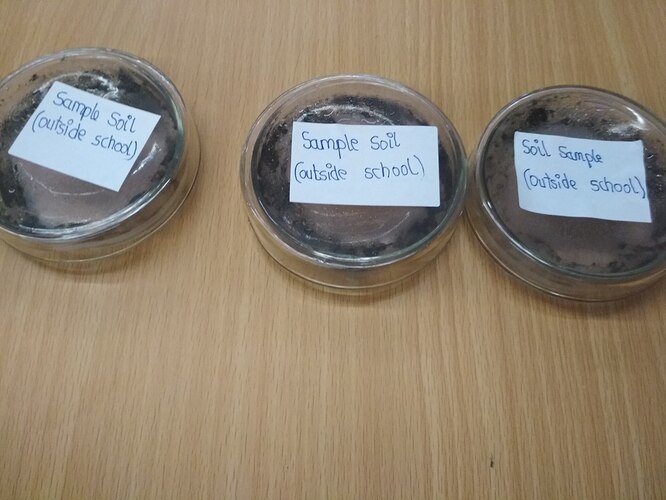Agar is a white powder
Bacteria is so small because they are prokaryotes which are unicellular
Plants may not have eyes or middle-ears, but they’ve got sensors that detect light and gravity, and you can really mess with the shape of a seedling by changing its position or lighting.
If you tilt a seedling on its side, within hours its stem will be making a turn upwards, and its roots heading down. You can do the same trick by changing the direction of the light source: seedlings will grow towards the light no matter what direction you shine it from.
Movement like this is slow and permanent, because it actually causes changes in cell growth.
Phototropism (growing towards light) occurs because the tips of growing plant shoots contain a pigment that’s sensitive to light, especially blue light. When light shines on the shoot, it gets absorbed by the pigment (called phototropin), and that triggers the release of the plant hormone auxin, which makes cells grow. The direction of the light determines where the auxin acts. If light is coming from the right, auxin gets sent down the left (shady) side of the shoot. That makes the cells on the shady side grow longer, putting a kink in the shoot so it points to the light.
Change the direction of the light and you can get a curve going in the other direction, but that sounds more like teasing than experimenting …
Gravitropism (growing towards or away from gravity, depending on which end of the plant you are) also relies on auxin. And the mechanism that’s thought to be behind it is brilliantly simple.
Cells in the root and shoot tips contain little packets of starch, called statoliths. The starch is dense so the statoliths always settle at the bottom of the cell. The position of the statoliths determines which direction auxin is released in. Tilting the plant on its side makes the statoliths roll and settle on the side of the cells, causing auxin to be released in that direction, and the cells there to elongate. Hey presto, curvy stem! Isn’t nature great?
gar or agar-agar is a jelly-like substance, obtained from red algae. Agar is a mixture of two components: the linear polysaccharide agarose, and a heterogeneous mixture of smaller molecules called agaropectin.
for more info on agar please visit this website
Cholera
TuberCulosis
Dysentery
Meningitis
Flesh- eating disease
“Is there any method to get solid medium without agar?”
Using agar medium we have helped all the microorganisms to grow. Then we solidified it and it formed like a gel . After this we put sand on the corners of the Petri dish and dropped a drop of dirty water filled with microorganisms to observe the growth of more microorganisms and we will be observing the microworms
You could use gelatin or starch… gelatin must not get hotter than 110°C, however. Thus, autoclaving is not possible.
Yes there are many methods
What is agar?? How does it solidifies
Gelidium is the preferred source for agars. Impurities, debris, minerals and pigment are reduced to specified levels during manufacture. Agar is a gel at room temperature, remaining firm at temperature as high as 65°C. Agar melts at approximately 85°C, a different temperature from that at which it solidifies , 32-40°C.
Agar is a jelly lile substance obtained from red algae🤔
“What are the common type of agar?”
Blood agar - contains blood cells from an animal (e.g. a sheep).
Chocolate agar - this contains lysed blood cells, and is used for growing fastidious (fussy) respiratory bacteria.
Neomycin agar - contains the antibiotic neomycin.
Sabouraud agar - used for fungi.
dont forget these
- Thayer-Martin agar - chocolate agar designed to isolate Neisseria gonorrhoeae .
- XLD agar - xylose lysine deoxycholate agar. It is used for the culture of stool samples, and contains two indicators. It is formulated to inhibit Gram-positive bacteria, while the growth of Gram-negative bacilli is encouraged. The colonies of lactose fermenters appear yellow.
- Nutrient agar - safe to use in school science laboratories because it does not selectively grow pathogenic bacteria.
- Hay Infusion agar - used for the culturing of slime moulds.
- MacConkey agar - MacConkey agar is both selective AND differential. The medium is used to differentiate between Gram negative bacteria while inhibiting the growth of Gram positive bacteria. The addition of bile salts and crystal violet to the agar will inhibit the growth of most Gram positive bacteria, making MacConkey agar selective. The medium also differentiates between lactose-fermenters and lactose nonfermenters. Lactose and neutral red are added to differentiate the lactose fermenters, which form pink colonies, from lactose nonfermenters that form clear colonies.
what is sterilisation and how do we do it
Sterilization refers to any process that eliminates, removes, kills, or deactivates all forms of life and other biological agents (such as fungi, bacteria, viruses, spore forms, prions, unicellular eukaryotic organisms such as Plasmodium, etc.) present in a specified region, such as a surface, a volume of fluid, medication, or in a compound such as biological culture media.(Sterilization (microbiology) - Wikipedia)[(Sterilization (microbiology) - Wikipedia) Sterilization can be achieved through various means, including: heat, chemicals, irradiation, high pressure, and filtration. Sterilization is distinct from disinfection, sanitization, and pasteurization, in that sterilization kills, deactivates, or eliminates all forms of life and other biological agents which are present.
